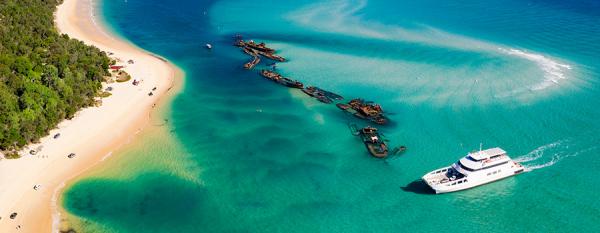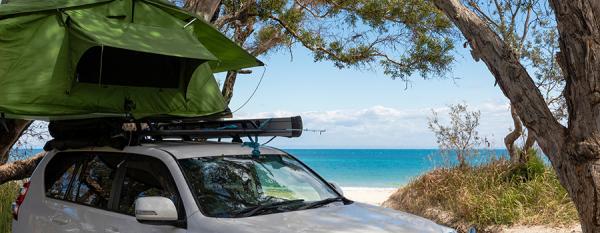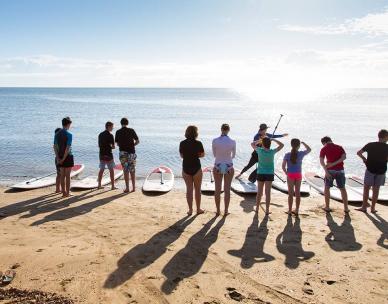

Moreton Island camping - everything you need to know
Think you need to travel further north for tropical island camping? Think again. No matter what you're into, you'll love Moreton Island (Gheebulum Kunungai), with snorkelling, diving, bird watching, sand tobogganing, bushwalking, fishing, and even dolphin feeding. Best of all, this island paradise is an easy 75-minute ferry ride from Brisbane.
Getting there and permits
As with all island adventures, there’s a bit of housekeeping you’ll need to do before jumping on the ferry, but unspoilt beaches, epic snorkelling and endless dunes are reward enough. First, book your ferry ticket. You can catch the vehicle ferry Micat, which operates on a demand-based timetable, from the Port of Brisbane. A passenger service goes from the Holt Street Wharf in Pinkenba, but you’ll probably want a four-wheel drive (4WD) if you’re camping.
It’s important to know that pets are not allowed on the island and mobile phone service is limited at best.

Permits
Before you travel, you'll need to book your campsite and organise a campsite permit and vehicle access permit which are all managed by Mulgumpin (Moreton Island) Camping. You will also need to display a camping tag with your booking number at your campsite during your stay.
4WD and equipment hire
The only way to navigate the island is by high-clearance 4WDs, so you can either bring your own or hire one in Brisbane. There is a transfer service on the island, but a 4WD is the recommended option for campers.
Be aware, there is no vehicle recovery service or mechanic on the island (it is a paradise island after all), so it’s highly recommended that you have your own recovery gear.
Don’t want to buy equipment for just one trip? Camping gear hire is available through a number of Brisbane retailers.
Where to camp
When choosing where to camp you can go with either dedicated campgrounds or secluded beach camping sites, though they generally have fewer facilities.
Long weekends and school holidays are busier, so if you’re after some serenity at these times, beach camping is a good choice.
The western side of the island is best for camping with kids for the calm waters (campgrounds are The Wrecks, Ben-Ewa and Comboyuro Point). The south-west side is quieter, but trickier to access.
Three important things to check before setting up camp:
Check that you are:
- in the correct campground or camping zone that you have booked,
- camping in an officially designated area. Camping is not allowed on the beach outside of official zones.
- camping only within the campsite footprint near the camping totem. Do not place tents or equipment outside of existing cleared areas or fenced sites.
National Park campgrounds
Here are the National Park and Recreation Area campgrounds you can choose from:
- The Wrecks
- Accessible by 4WD and boats. Vehicles must be left on the beach, leaving a short walk to the camping spots.
- Not accessible by trailers, caravans or buses.
- Ben-Ewa
- Best for first-time campers.
- Accessible by trailers and caravans.
- Located in a valley that offers protection from strong winds.
- Comboyuro Point
- Accessible by trailers and caravans.
- On the western side of the island, within walking distances of Bulwer township.
- North Point
- Not accessible by trailers or caravans.
- Close to surf beaches and Honeymoon Bay.
- Large, grassy and defined sites, many with shade.
- Blue Lagoon
- On the eastern side of the island.
- Easy access to surf beaches and walking distance to the Blue Lagoon.
- Accessible by trailers and caravans, though access via Middle Road is not recommended as it's a narrow one-way track with soft sand.

Beach camping
There are five beach camping zones on the island and visitors must only camp on the beaches within these zones. Beach campers also need to bring their own essentials including drinking water and rubbish bags.
The north-west camping zone, Yellow Patch camping zone, south-west camping zone and the south-east camping zones are all accessible for trailers and caravans. However, access to the south side zones via the single-laned Middle Road is not recommended for heavier rigs. The north-east camping zone can be reached only by 4WD, on foot, boat and kayaks.
What to see and do on Moreton Island
As the third-largest sand island in the world, Moreton Island has some of the most pristine beaches and freshwater lakes in Queensland. There are 4WD tracks to all of these attractions and the main sites listed below.
Freshwater lagoons, lakes and pools
Bathe in the natural Champagne Pools of Honeymoon Bay or take a refreshing dip in the stunning Blue Lagoon. The water in the lagoon is full of tea tree oils and can be a bit cool, but you'll never have softer hair! It is also a renowned bird watching hub.
Snorkelling the Tangalooma Wrecks
The Tangalooma Wrecks are a series of old sunken ship hulls made for snorkelling or scuba diving. The crystal-clear water is perfect to get up close with marine life, such as tropical fish, coral, and if you're lucky, local green turtles. To explore this underwater paradise on your own, bring your own snorkelling gear or hire gear from Australian Sunset Safaris.

Sand tobogganing, Mount Tempest and hiking to Cape Moreton Lighthouse
The highest point on the island is the 280-metre-high Mount Tempest — one of the highest coastal sanddunes in the world. While you can hike to the summit, you can't sandboard down this mountain, but there are plenty of other spots to sandboard on Moreton Island. The Desert (centre-west of the island) and Big and Little Sand Hills (in the south) are the best spots and great for beginners. The Big Sand Hills area has very steep dunes (around 90 metres) perfect for serious adrenalin junkies.
Hiking is one of the best ways to appreciate Moreton Island's diverse range of native plants, birds and wildlife. Mount Tempest offers a stunning 360-degree view where you can see the coastline from the Sunshine Coast and Glasshouse Mountains to Brisbane and the Gold Coast on a clear day.
The island also has many well-maintained walking tracks, ranging from short, easy bushwalks to half-day hikes. The tracks traverse stunning spots including the iconic Cape Moreton Lighthouse (the first lighthouse to be built in Queensland), Honeyeater Lake (abundant with wildflowers and birdlife), Five Hills Lookout (with views of Heath Island) and the picturesque Blue Lagoon.
Kayaking - day or night
If you're camping near Bulwer (Comboyuro Point is the closest campsite), check out Australian Sunset Safaris for equipment hire and tours. Clear-bottom kayaks can be hired most days from 10am-3pm for do-it-yourself paddles, or you can book a night guided kayaking tour.

Day trips
If you're staying on Moreton, a great day trip around the island is to drive down Eastern Beach to the southern end of the island and stop in at the township of Kooringal. Enjoy a cold drink or ice-cream at the unique Gutter Bar — a quintessential Queensland drinking hole immersed in the mangroves. Afterwards, head north and you'll find an oyster farm selling trays of the freshest Moreton Bay oysters...bottoms up! To round out the day, continue further north from Kooringal to sand toboggan the day away.
More ideas to explore Brisbane's big backyard
Once you've explored the sandy paradise of Moreton Island, it's time to hit the water and learn more about Moreton Bay's world-class whale watching.
There's so much to see and do in Brisbane. Check out our other Day Out articles, videos and itineraries for more fabulous ideas.
If you enjoyed this article, you might also like:
- Wynnum and Manly | Coastal escape just 30 minutes from the CBD
- Sandgate | Explore Brisbane's bayside beach
- Where to go walking and hiking in Brisbane.
**This article was updated in March 2024.**
Editor's note: The featured content in Brisbane Explore is created to inspire residents and visitors to plan a day out exploring Brisbane. Brisbane City Council disclaims any relationship with, or endorsement of, businesses featured in this article.
Nearby events
Bookings essential. Learn the basics of stand-up paddle boarding. This lesson includes safety instruction, paddle techniques and activity tips. All equipment is...
Bookings essential. Learn the basics of stand-up paddle boarding. This lesson includes safety instruction, paddle techniques and activity tips. All equipment is...
Bookings essential. Learn the basics of stand up paddle boarding. This lesson includes safety instruction, paddle techniques and activity tips. All equipment is...
Bookings essential. Learn the basics of stand up paddle boarding. This lesson includes safety instruction, paddle techniques and activity tips. All equipment is...

